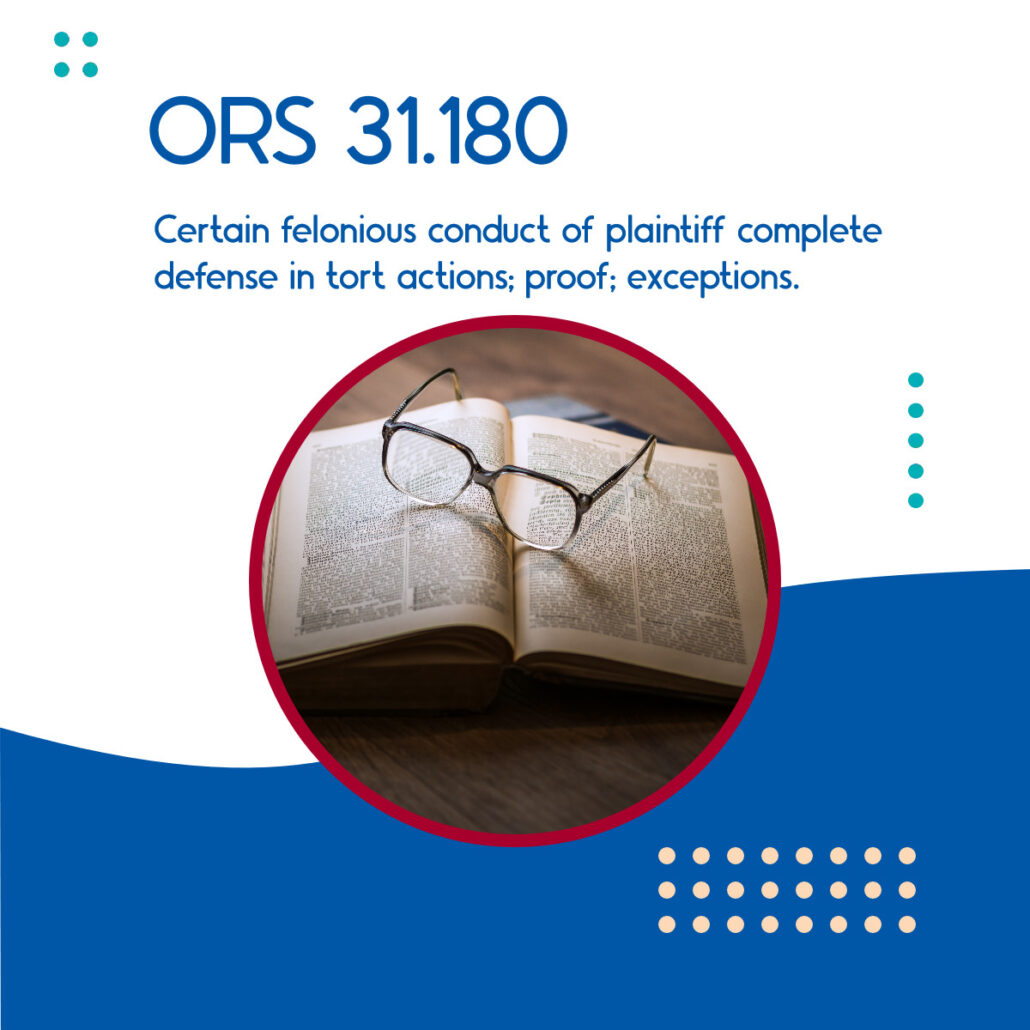Think of ORS 31.180 as a specific rule in civil law cases. It basically says:
- When It Applies: If someone is injured or killed, and at that time they were committing a serious crime (like aggravated murder, murder, or a major felony), this fact can be used as a defense in a lawsuit against the person or entity being sued for causing that injury or death.
- How to Prove It: The person being sued (the defendant) needs to show that it's more likely than not that the injured or deceased person was committing this serious crime at the time of their injury or death.
- Exceptions to the Rule: This defense doesn't work in all situations. For example, if the injury or death was caused by an illegal trap (like a springgun) or by force that wasn't legally justifiable, then this defense can't be used.

In essence, ORS 31.180 allows defendants in lawsuits to argue that the person who got hurt or died was at fault because of their involvement in a serious crime at the time. This law is there to prevent people from benefiting (like getting a settlement in a lawsuit) from their own wrongful actions. However, it also makes sure that this defense is not applicable in cases where the injury or death was caused in certain wrongful ways.
This rule strikes a balance between holding individuals accountable for their actions and ensuring that defendants can't use this defense in situations where the injury or death was caused by their own wrongful acts.
ORS 31.180
ORS 31.180 outlines a specific legal defense in Oregon for civil actions involving personal injury or wrongful death. This statute provides that if the person injured or deceased was engaged in certain felonious conduct at the time of their injury or death, it can be used as a complete defense in the civil case. The key elements of this defense are:
- The injured or deceased person must have been involved in conduct that would be considered aggravated murder, murder, or a Class A or Class B felony at the time of the injury or death.
- This felonious conduct must have been a substantial factor contributing to their injury or death.
To successfully use this defense, the defendant must prove by a preponderance of the evidence that the injured or deceased person was engaged in such felonious conduct.
However, there are exceptions to this defense:
- It cannot be used if the injury or death resulted from a springgun or similar device that violated ORS 166.320.
- The defense is also unavailable if the injury or death resulted from the use of physical force that was not justifiable under the standards set by ORS 161.195 to 161.275.
This statute ensures that in certain cases, where the injured or deceased person's own criminal actions were a significant factor in their harm, the person or entity being sued can use this as a defense. However, it's important to note that this defense has specific limitations and exceptions, ensuring it is applied only under appropriate circumstances
ORS 31.180 Text
31.180 Certain felonious conduct of plaintiff complete defense in tort actions; proof; exceptions.
(1) It is a complete defense in any civil action for personal injury or wrongful death that:
(a) The person damaged was engaged in conduct at the time that would constitute aggravated murder, murder or a Class A or a Class B felony; and
(b) The felonious conduct was a substantial factor contributing to the injury or death.
(2) To establish the defense described in this section, the defendant must prove by a preponderance of the evidence the fact that the person damaged was engaged in conduct that would constitute aggravated murder, murder or a Class A or a Class B felony.
(3) Nothing in this section affects any right of action under 42 U.S.C. 1983.
(4) The defense established by this section is not available if the injury or death resulted from a springgun or other device described in ORS 166.320 and the plaintiff establishes by a preponderance of the evidence that the use of the springgun or other device constituted a violation of ORS 166.320.
(5) The defense established by this section is not available if the injury or death resulted from the use of physical force that was not justifiable under the standards established by ORS 161.195 to 161.275. [Formerly 30.698]
ORS 31.180
What Does That Mean?
ORS 31.180 provides a legal defense in civil lawsuits involving personal injury or wrongful death. This defense is applicable under specific conditions:
- Involvement in Felonious Conduct: The defense can be used if the injured or deceased person was engaged in serious criminal activities, specifically aggravated murder, murder, or a Class A or Class B felony, at the time of their injury or death.
- Connection to Injury or Death: The individual's criminal conduct must have significantly contributed to their own injury or death.
Proving the Defense: For this defense to be valid, the defendant (the person being sued) must demonstrate by a preponderance of the evidence (more likely than not) that the injured or deceased person was involved in such criminal activities.
However, there are important exceptions to this defense:
- Springgun or Similar Devices: The defense cannot be used if the injury or death was caused by a springgun or similar device that was used in violation of ORS 166.320.
- Unjustifiable Physical Force: It is also not applicable if the injury or death was a result of physical force that was not justifiable according to Oregon's standards for the use of force (ORS 161.195 to 161.275).
Essentially, ORS 31.180 allows defendants in personal injury or wrongful death lawsuits to claim that the person who was injured or died was at fault due to their involvement in serious crimes at the time. This defense is grounded in the principle that one's illegal actions, which contribute to their own harm, can be a valid defense in a lawsuit. However, it ensures that this defense is not misused by setting clear boundaries on when it can be applied
Related Laws
ORS 166.320 addresses the issue of setting up springguns or setguns. It states that setting up any loaded springgun, setgun, or similar device designed to fire or explode upon contact with a string, wire, or other trigger mechanism is illegal and constitutes a Class B misdemeanor. This law is in place to prevent the use of potentially dangerous and unpredictable traps that could harm people or animals. However, there's an exception for devices set up for controlling pests like gophers, moles, or other burrowing rodents, and for the use of coyote getters by governmental employees in predator control activities.
As for ORS 161.195 and ORS 161.275, these statutes are part of Oregon's laws on justifiable use of physical force. ORS 161.195 covers the justification for using physical force in self-defense, defense of others, and defense of premises. It outlines under what circumstances the use of force is legally acceptable. ORS 161.275, on the other hand, deals with the defense of entrapment. It provides guidelines on when an individual can claim entrapment as a defense, essentially when someone is induced by law enforcement to commit a crime they would not have otherwise committed.
These laws, when considered together, provide a legal framework for understanding the limits and justifications for using physical force and setting potentially harmful traps, ensuring public safety and legal accountability.
We will review your case for free.
Pay us nothing unless we get you a better settlement.
We work on contingency.

